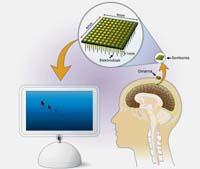Paralysis of limbs: a miracle

Five years ago the young Matt Nagle was given a knife in the column. Since then it has paralyzed extremities. However, it is now able to use email, change the volume of the television and move a robotic arm. And all this with just thinking.
For this purpose it uses the BrainGate system. The system, created at the University of Brown and developed by the company Cyberkinetics, allows to transfer to a computer the orders created in the brain. In fact, in this type of injury the motor nerves do not respond, but many times in the motor area of the brain there are no problems creating orders.
Therefore, the system has 96 tiny electrodes that are placed in the motor area. The electrodes collect the order created in the brain and direct it to the base fixed in the skull. From there the order arrives to the computer and does what the computer tells you, both on a screen and through a robotic tool.
However, the system has some 'but': only a few movements can be performed and, when the inside and outside of the body are connected, there is a great risk of infection. In addition, they have tested with other volunteers and the results have not been so good. Therefore, scientists intend to continue investigating to improve the system.
Other researchers, for example, are based on electroencephalograms. The electroencephalograms are performed by placing the electrodes on the outside of the head, so no surgery is necessary. Afterwards, a computer interprets images generated by brain activity and executes orders. At the moment, the results that are being obtained are not very good, but they are also being tested on that path. In search of a solution.

Motor neurons of stem cells
There are other ways to try to overcome paralysis. The above are based on the transmission of brain orders to a computer. Another way is to replace the affected motor neurons. To do this, they leave the stem cells: if the stem cells develop motor neurons and they are made functional, the paralytics could make movements.
Researchers at the Johns Hopkins Institute have already done so in rats paralyzed by a virus. It seems that the most difficult thing was to find the proper mixture of the necessary agents in the process of conversion of stem cells into functional neuron, and it seems that on this occasion they have successful since 11 of the 15 rats they have tried have managed to make some movements.
Now they want to experiment with pigs. The stem cells of human embryos will develop precursors of motor neurons and incorporate them into pigs, along with the mixture of agents tested in rats. There is a long way to go in humans, but this experiment is a reflection of the important advances that are being made in stem cell research.
Buletina
Bidali zure helbide elektronikoa eta jaso asteroko buletina zure sarrera-ontzian











